


Oscillating reaction
A remarkable type of chemical reaction is the so-called oscillating reaction. The best known oscillating reaction is the Belousov-Zhabotinsky reaction. This is based on the oxidation of malonic acid to carbon dioxide by bromate. The reaction seems to be oscillating, but physically speaking, it is not a real oscillator. The reaction simply is a one-way reaction, where the system progressively moves from a higher energy state to a lower energy state. A chemical system cannot be a true oscillator, because chemical reactions never oscillate around a certain equilibrium in a way, which can be done by mechanical or electronic systems. Chemical "oscillations" only can occur in a situation, far from equilibrium.
This reaction makes up for a very good demonstration. The best demonstration is made by using large amounts of chemicals and using a volume of several hundreds of ml of solution, but unfortunately this is not feasible for the home chemist. One of the chemicals, malonic acid, needed for this experiment, is quite expensive and one would not like to use many grams of this for a single experiment. The experiment, described here, can be done on test tube scale with only tens of mg quantities, while still being very surprising, also for showing it to family and friends.
![]()
![]() Required
chemicals:
Required
chemicals:
-
dilute sulphuric acid (1 to 2 mol/l, not critical)
-
potassium bromate
-
manganese sulfate *
-
malonic acid, CH2(COOH)2
-
ferroin **
![]() Required
equipment:
Required
equipment:
-
test tubes
-
safe way to heat contents of a test tube
-
clamp
![]() Safety:
Safety:
- Dilute sulphuric acid is fairly corrosive. In case of contact with skin, quickly rinse with a lot of water.
- Potassium bromate probably is a human carcinogen. There are some doubts on its real toxicity, but it is better to be safe than sorrow.
![]() Disposal:
Disposal:
- After the experiment, the solution can be flushed down the drain.
* If you have no manganese sulfate, then you can take potassium permanganate. Dissolve this in dilute sulphuric acid, and add just enough sodium (bi)sulfite to make the solution colorless and boil for a while to get rid of excess sulphur dioxide. This solution has Mn2+ ions in it, and that is perfectly suitable for this experiment. Manganese nitrate or manganese acetate can also be used instead of the manganese sulfate. Chloride, however, cannot be used. Chloride really kills this experiment, even very small amounts of chloride spoil the experiment.
** If you have ferroin, then add a very small amount of this to the mix. This is an indicator, which does not influence the reaction, but makes the observed colors much stronger (deep blue). Unfortunately I have no ferroin, so the images and videos, given below are with the somewhat weaker colors of the reaction without ferroin.
Potassium bromate can be replaced by sodium bromate.
An alternative experiment can be done with cerium(IV) salts. Any cerium(IV) salt is suitable, e.g. ceric sulfate, ceric ammonium sulfate, or ceric ammonium nitrate.
![]()
Preparation of solution 1
![]() Take a
few ml of distilled water, tap water will spoil the experiment, due to
the presence of chloride ions.
Take a
few ml of distilled water, tap water will spoil the experiment, due to
the presence of chloride ions.
![]() Add a
small spatula of malonic acid and a small spatula of manganese sulfate to this
and then dissolve both solids. This yields a colorless and clear solution.
Precise quantities are not at all critical, estimated amounts are a few tens of
mg for each of the two chemicals.
Add a
small spatula of malonic acid and a small spatula of manganese sulfate to this
and then dissolve both solids. This yields a colorless and clear solution.
Precise quantities are not at all critical, estimated amounts are a few tens of
mg for each of the two chemicals.
As an alternative, one can use a solution, containing Mn2+ ions, made from an acidified potassium permanganate solution, as described above. To this solution, the malonic acid is added.
![]() Finally,
heat the test tube, such that its contents is almost boiling and then fix the
test tube in a clamp, such that it is not easily moved (motion during the
reaction makes the oscillation irregular and makes the experiment less
surprising).
Finally,
heat the test tube, such that its contents is almost boiling and then fix the
test tube in a clamp, such that it is not easily moved (motion during the
reaction makes the oscillation irregular and makes the experiment less
surprising).
![]()
Preparation of solution 2
![]() Take a
small amount of dilute sulphuric acid, and add a small spatula of potassium
bromate. Heat this until all potassium bromate is dissolved. This may take some
time and requires one to make the solution quite hot. Potassium bromate does not
dissolve well in cold water, nor in cold dilute sulphuric acid.
Take a
small amount of dilute sulphuric acid, and add a small spatula of potassium
bromate. Heat this until all potassium bromate is dissolved. This may take some
time and requires one to make the solution quite hot. Potassium bromate does not
dissolve well in cold water, nor in cold dilute sulphuric acid.
The potassium bromate need not be very pure, as long as it is free of chloride. Traces of bromide are not a problem at all for this experiment.
![]()
The actual reaction
Pour the still hot solution 2 in the hot solution 1. Immediately, a brown color can be observed, and the liquid starts bubbling fairly vigorously. After an initial irregular transient, the reaction shows nice shots of brown color, every few seconds, while in the meantime the solution is colorless. These shots of brown color are like in the sequence below. Starting at colorless, going to red/brown and then back to colorless. The sequence below covers approximately 500 ms.
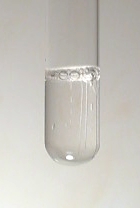
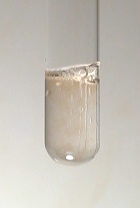
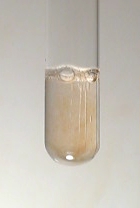
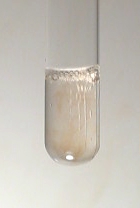
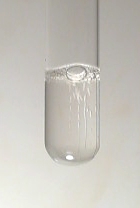
After approximately 1 minute, the shots of brown color become more vague and finally, only a colorless and bubbling solution remains.
Click here for a small video, which shows approximately 1 minute of the reaction. This video nicely shows the regularity of the oscillations. If the video does not play correctly by simply clicking, then save the file to the local harddisk and try to do the playback from that location.
![]()
Sensitivity to shaking
Another remarkable observation with this reaction is that it is quite sensitive to shaking and also to general motion of the liquid. When the reaction is performed, with the test tube in the hand, instead of a fixed clamp, then a single motion can trigger the darkening of the liquid, but it can also cause the fast formation of gas bubbles. In any case, when the test tube is kept in one's hand and is moved around, then still the oscillations can be observed, but they are very irregular and events seem to be triggered by the motion.
Also quite interesting is that if the reaction seems to be over and no more brown shots appear, then one can take the test tube out of the clamp and shake it quite vigorously. If that is done, then one can obtain other few shots of brown color. This effect can be observed, by clicking here.
![]()
Alternative reaction with cerium(IV) instead of manganese(II)
This oscillating reaction also can be performed with a cerium(IV) salt, instead of a manganese(II) salt. In order to do the experiment in this way, again two solutions must be prepared. Solution (1) now is prepared from 1 small spatula of potassium bromate, a small amount of cerium(IV) sulfate or other cerium(IV) salt, dissolved in a few ml of 1 M sulphuric acid. Solution (2) now simply is a solution of malonic acid in 1 M sulphuric acid. Precise quantities are not critical at all.
Both solutions must be heated somewhat (40 ºC or so) and then mixed. As soon as the liquids are mixed, a vigorous reaction starts, and the oscillations start. A video of this reaction can be downloaded here: yellow oscillation. Download size is just over 3.5 MByte.
![]()
Discussion of the results
Describing this type of reaction in an adequate way is amazingly difficult. The chemical reactions are fairly well understood, but the dynamics of this reaction can be really amazing.
The net reaction in the presence of excess malonic acid is as follows:
3CH2(COOH)2 + 4BrO3– → 4Br– + 9CO2 + 6H2O
The extra acid in the form of sulphuric acid and the manganese (II) ions in the solution are catalysts only. The special thing about this reaction, though, is that the catalytic action is on a macroscopic time scale and not in the nanosecond or even shorter time range. This allows one to actually see the dynamics of a chemical reaction unfold while watching it.
A very readable and easy to understand description of the reaction is given in the following paper. Only basic mathematics are needed to understand it:
http://www.rose-hulman.edu/mathjournal/archives/2002/vol3-n1/paper1/v3n1-1pd.pdf
The paper describes the variation of the reaction with Ce3+/Ce4+ as the catalyst, but the use of Mn2+/Mn3+ results in very similar mathematical models. The mechanism of the reaction is the same for both metals. In fact, any metal, which reversibly can switch between a state Mn+ and M(n+1)+ is suitable if there is sufficient difference in the redox potential between the two oxidation states and on the other hand the difference is not too large. Most suitable are the Ce and Mn systems, but there are also studies with certain Ru-complexes, which have a similar redox chemistry.
Summarizing, the reaction proceeds in many different steps, with a few steps at low rates, and other steps at much higher rates. For a perfectly stirred solution with the same concentration everywhere, the very fast steps can be regarded as being in equilibrium always (semi-static behavior), which leads to a model of low order, with just a few non-linear ordinary differential equations for the concentration of a few compounds in solution. This set of equations can be described as follows:
du/dt = F(u) + I(t)
dx/dt = Gu(x)
The meaning of the symbols is as follows:
- The vector x is a state vector of at least three different variables (concentrations of certain intermediate compounds in solution).
- The variable u is a value, depending on the concentration of a set of reagents {U}, which slowly decreases as one or more of the compounds in {U} are used up. For certain values of u, the model dx/dt = Gu(x) can show oscillatory, or even chaotic behavior.
- F and Gu are (vector)functions, which describe the model, with Gu being parameterized by the concentration u. The function I(t) describes the inflow of {U} into the system from an external source.
The driving force of the oscillation is the presence of reagents {U}. As long as sufficient {U} is present in solution, the reaction will continue and the system dx/dt = Gu(x) shows oscillatory or chaotic behavior. In the case of the experiment, done here, {U} = {KBrO3, CH2(COOH)2}. As long as both chemicals are present in sufficient quantity, the reaction will continue. These chemicals are used up by the reaction. At a certain point, the concentration of one, or both, decreases so much, that the model dx/dt = Gu(x) does not exhibit oscillatory or chaotic behavior anymore. In the paper, given above, an actual model F, Gu is derived, which is not described in more detail over here. A more qualitative description of the reaction is given at the following website:
http://online.redwoods.cc.ca.us/instruct/darnold/deproj/Sp98/Gabe/
The reaction could be carried out, with a continuous inflow I(t) of solutions of KBrO3 and CH2(COOH)2, while the mix is well stirred and the catalyst is immobilized, such that it does not disappear from the system. Under such conditions, the oscillatory behavior can exist for an unlimited time. For a home chemist, however, such conditions are not easy to achieve and necessarily the oscillation time is limited. In a model without inflow of {U}, the function I(t) equals 0.
For a non-shaken or irregularly shaken medium, the reaction dynamics become amazingly complex and no good finite dimensional model can be derived anymore. The equation, as described above now also contains diffusion terms, which depend on the location in the liquid.
du/dt = F(u) + I(t) + DT(u)
dx/dt = Gu(x) + DT(x, u)
Such a model would be a set of partial differential equations with functions of time, but also of spatial coordinates. This is represented by the terms DT(...), which depend on values of x and u as function of spatial coordinates (x, y, z). The bubbling makes things even more complicated. The experiment, as it is performed here, only seemingly shows regular behavior, but the underlying dynamics and associated math is well beyond what can be described and simulated with current PC-hardware.
![]()
Remark: The reaction can also be carried out with citric acid instead of malonic acid (this is how Belousov did the experiments in the 1950's when he discovered this type of reactions). With citric acid, the reaction, however, is much less appealing visually. This is due to the final reaction product with citric acid. The citric acid product is some oily brominated organic, which becomes finely dispersed in the liquid, making it turbid and milky white, while with malonic acid, the liquid remains clear and the final product, carbon dioxide, simply bubbles away from the solution.